#dried flowers india
Text
Bridal Hair Flowers & Accessories in Ahmedabad, Gujarat, IN | HK Hair
Find stunning bridal hair accessories flowers and flower hair pins for your special day at HK Hair. Our collection of dry flowers and flower hair accessories will elevate your look.
For More Information:-https://hkhair.in/product-category/dry-flowers/
#bridal hair accessories flowers#Dried Flower Hair Accessories#Wedding Flower Headband Hair Accessories for Women#Buy Dried Flower Hair Online In India#bridal hair flowers#Flower hair band for wedding near me#dried flower hair band#flower hair band for wedding near ahmedabad
0 notes
Text
Buy Dried Flower Bouquet | Bouquet Arrangement
Dry Flowers Bouquet for Long Vase | 100% Naturally Dried | Perfect for Wedding, Anniversary, Gifting, Home & Office Decoration.
















#dry flower#sola flower#artificial flower#dried flower bouquet#dried flower arrangement#dry flower for sale India
1 note
·
View note
Text

Create a serene atmosphere with our Pampas Grass Sticks. Ideal for minimalist interiors looking for a hint of nature's beauty. Shop now and avail great offers and deals! Visit us: https://shop.eikaebana.com/
#pampas grass stick#grass sticks#dried sticks#flowers#eikaebana flower shop#india#artificial flowers
0 notes
Text
Herbalism 101: Lavender

Fun Fact: Lavender is a part of the mint family; making it a natural insect repellent.
English lavender (Lavandula angustifolia) is an excellent way to add a mid-summer pop of color to your garden or patio. Planting is somewhere where you can enjoy its beautiful scent. English lavender is more tolerant of colder temperatures common in the Marquette area than French lavender, making it an excellent choice for herb gardens and perennial borders. This is a member of the mint family features aromatic leaves and flowers that are popular for cooking purposes, medicinal use, and home projects.
Lavender is prized as a culinary ingredient. Lemon and lavender make a great combination for baking cookies, cakes, and other delicacies. Lavender can also be used to infuse simple syrups for cocktails or lemonades.
Lavender’s lovely scent is known to reduce anxiety and calm the mind. The calming fragrance of a lavender plant is thought to provide relief from stress, depression, and migraines. It is also considered anti-inflammatory and has antiseptic properties.
Lavender attracts beneficial pollinators to its flowers. Adding lavender to your garden will attract butterflies, bees, and other helpful insects.
Lavender plants are deer resistant. Making them a welcome addition for many homeowners looking for plants they don’t have to share with the local wildlife.
Lavender from your garden can be dried and used to create items such as homemade lavender soap, bath salts, potpourri, sachets, and cleaning products.
Lavender does well in most climates. The plant is drought resistant and will form a large swath of flowering plants. The blue flowers are not only beautiful but smell fabulous. You can harvest the blooms through the summer and prune the plant back in the fall.
-flower works blog
Lavender is a flowering plant in the mint family that’s easily identified by its sweet floral scent. It’s believed to be native to the Mediterranean, The Middle East, and India, with a history dating as far back as 2,500 years.
According to everyday health blog, Possible health benefits of Lavender include:
May help improve sleep.
Can help treat skein blemishes.
May offer a natural remedy for pain.
Reduce blood pressure and heart rate.
Could relieve asthma symptoms.
Help combat fungus growth.
Potentially promotes hair growth.
Helps relieve stress.
Lavender hasn’t been approved by the FDA, so it’s important to be aware of potential health risks or side effects of using this herb.
📷© Pinterest
#witch#kitchen witch#pagan#witch blog#herbs#witchcraft#kitchen witchery#green witch#hearth witch#herbal magick#witchy#pagan witch#witch aesthetic#witches#witchyvibes#baby witch#cottage witch#earth witch#forest witch#hedge witch#kitchen witchcraft#lunar witch#nature witch#witch community#witch core#witch familiars#witch history#witch tips#witchblr#witchcore
340 notes
·
View notes
Text

okay I think we should take inventory of what we learned about Marius's house.
In fact, the impression was one of comfortable messiness.
(i think the tiktok kids started calling ADHD clutter clustering or something LMAO marius de romanus cluster girlie i guess. thanks i hate it)
Here's some stuff that Marius had on his island!!!!!!!
stone benches
a lighted oil lamp on a stand
a pair of heavy wooden doors
a sarcophagus with a plain lid, cleanly fashioned out of diorite
The lid plated in iron and contained
a golden mask, its features carefully molded, attached to a hood made up of layered plates of hammered gold.
a pair of leather gloves covered completely in tinier more delicate gold plates like scales.
a large folded blanket of the softest red wool with one side sewn with larger gold plates
Magnificent Grecian urns on pedestals in the corridors
great bronze statues from the Orient
exquisite plants at every window and terrace open to the sky.
Gorgeous rugs from India, Persia, China c
giant stuffed beasts mounted in lifelike attitudes-
--the brown bear,
--the lion,
--the tiger,
--even the elephant standing in his own immense
chamber,
--lizards as big as dragons,
--birds of prey clutching dried branches made to look like the limbs of real trees.
brilliantly colored murals covering every surface from floor to ceiling
a dark vibrant painting of the sunburnt Arabian desert complete with an exquisitely detailed caravan of camels and turbaned merchants moving over the sand
a jungle warming with delicately rendered tropical blossoms, vines, carefully drawn leaves
creatures everywhere in the texture of the jungle-
--insects,
--birds,
--worms in the soil-
too many monkeys in the jungle,
too many bugs crawling on the leaves.
thousands of tiny insects in one painting of a summer sky.
a large gallery walled on either side by painted men and women staring at me
Figures from all ages these were-
--bedouins,
--Egyptians,
--Greeks and Romans,
--knights in armor,
--peasants
--kings
--queens.
--Renaissance people in doublets and leggings,
--the Sun King with his massive mane of curls,
--people of our own age.
droplets of water clinging to a cape,
the cut on the side of a face,
the spider half-crushed beneath a polished leather boot.
a library, blazing with light.
Walls and walls of books and
rolled manuscripts,
giant glistening world globes in their wooden cradles,
busts of the ancient Greek gods and goddesses,
great sprawling maps.
Newspapers in all languages lay in stacks on tables.
Fossils,
mummified hands,
exotic shells.
bouquets of dried flowers,
figurines and fragments of old sculpture,
alabaster jars covered with Egyptian hieroglyphs.
comfortable chairs with footstools,
candelabra or oil lamps.
a forest of cages.
birds of all sizes and colors
monkeys
baboons,
Potted plants crowded against the cages-
--ferns and
--banana trees,
--cabbage roses,
--moonflower,
--jasmine,
--other sweetly fragrant nighttime vines.
purple and white orchids,
waxed flowers that trapped insects in their maw,
little trees groaning with peaches and lemons and pears.
a hall of sculptures equal to any gallery in the Vatican museum.
adjoining chambers full of paintings,
Oriental furnishings,
mechanical toys.
fine rosewood paneling with framed mirrors rising to the ceiling.
painted chests,
upholstered chairs,
dark and lush landscapes,
porcelain clocks.
A small collection of books in the glass-doored bookcases,
a newspaper of recent date lying on a small table beside a brocaded winged chair.
the stone terrace. where banks of white lilies and red roses gave off their powerful perfume.
a pair of winged chairs that faced each other
a dozen or so candelabra and sconces on the paneled walls.
brocade cushions
#marius de romanus#tvl quotes#the vampire lestat#marius's elephant tag#tag urself im worms in the soil#Vampire chronicles
27 notes
·
View notes
Text
Preserving Leaf Paintings in an Anglo-Indian Commonplace Book, 1822-1825
Hello, I’m Alexa Machnik, a third-year graduate student at the Conservation Center, Institute of Fine Arts, NYU. I first came to the Barbara Goldsmith Preservation & Conservation Department in Fall 2022 as a student in the graduate course, Conservation in Context, taught by Laura McCann, Director of Preservation. During this course, we delved into the world of library conservation, exploring the value systems that guide preservation decision-making and treatment action in academic research libraries. One of my class projects involved rehousing delicate leaf paintings from an early 19th-century commonplace book, or friendship album, part of the Fales Library holdings in the Special Collections at NYU Libraries (figs. 1-2) [1]. In honor of Preservation Week, I will share the intriguing history of the book and discuss the decisions that were made to preserve the leaves.

Figure 1 [left]: Front cover of the commonplace book, bound in gold-tooled red morocco leather.
Figure 2 [right]: Ownership label of “Jane Harriet [Blechynden]” on front marbled pastedown.
The book in question was compiled by Jane Harriet Blechynden (1806-1827) in England between 1822 and 1825. It holds her personal collection of handwritten and acquired materials, with contributions from her sisters, Emma and Sarah, who wrote original poems about sisterhood, separation, and their Anglo-Indian ancestry. The three women were the daughters of a British merchant residing in Calcutta, and while born in India, they were educated in England [2]. There is not a great deal known about Jane Harriet’s life in England, but her impending return to India in 1825 is documented in an emotional verse by Emma (fig. 3):
“Thus in parting my sister we’re breaking a link / Which may ne’er be united again / And firm as that chain was ‘tis painful to think / That absence may send it twain.”

Figure 3: Excerpt from the original poem, “Parting and a Meeting,” signed by Emma.
Jane Harriet’s book offers insights into her personhood, social connections, and sensibilities as an artist and collector. In addition to written entries, she inserted a compendium of acquired materials–pressed flowers, her own original drawings, and numerous paintings–between pages of the book (figs. 4-6).

Figures 4-6 [left to right]: A small sampling of the ephemeral treasures found in the book, including a dried pressed flower, a drawing on pith possibly by Jane Harriet, and a cut-paper silhouette.
Notably, six of these paintings are executed on the dried leaves of the Bodhi tree, a sacred plant indigenous to Asia with distinct spade-shaped, long-tipped leaves (fig. 7) [3]. Although leaf painting has origins in Buddhist traditions, by the time Jane Harriet collected her leaf paintings, it had already evolved into a form of Chinese export art in Europe. Her leaves depict secular scenes of contemporary life in China and botanical subjects, which are typical of the export genre (fig. 8). Their inclusion in the book implies that Jane was among the many people who partook in the avid collecting of China trade goods during the first few decades of the 19th century, a time when European fascination for Chinese culture and art was at its peak.

Figure 7: A leaf painting, as found loose in the book and partially lifted to show the thin, translucent nature of the leaf support.

Figure 8: Another leaf painting from the book, oriented with the leaf tip at the bottom of the image, depicting flowers and a butterfly.
The initial rush of excitement that I felt at finding the leaf paintings soon turned to concern as I gave thought to their long-term preservation at NYU Libraries, where researchers are expected to handle the book. The leaf paintings were loose in between the pages, which raised a series of “what ifs” about the potential dangers they could encounter. What if the leaves slip from the book? What if they bend or break as the pages are turned? What if the painted surfaces become abraded? The paintings were made with opaque pigment-based watercolors on exceptionally delicate, skeletonized leaves that have been primed with a thin organic coating. Despite being intact, their inherent fragility means that they are vulnerable to even the slightest touch. After considerable discussion, the Conservation Unit decided that in order for the leaf paintings to be preserved and safely accessed by researchers, they should be housed separately from the book.
I thoroughly examined the condition of the leaves and the painted surfaces in order to make a housing recommendation. Despite some minor damage, all were in stable condition. Thus, the ideal housing would provide support to prevent any further damage, such as paint loss and leaf breakage, and at the same time allow the leaves to maintain their translucency. To achieve this, I opted to mount them in double-sided window mats with a support made from clear polyester film, or Mylar® [4]. The addition of the Mylar® would not only create a stable surface for the leaf paintings but also enable the viewing of both sides (fig. 9).

Figure 9: View of the double-sided window mat with a Mylar® support.
My next challenge was to figure out how to mount the leaves onto the Mylar® support without the use of adhesive [5]. After consulting with conservation staff and creating mock-ups, short, discreet Mylar® tabs were selected as the best option to secure them into place (figs. 10-11). For this process, I positioned a single leaf painting onto the support and selectively placed the tabs around its perimeter, making sure the tabs did not overlap any areas of paint. I then used a handheld spot-welding pen to fuse the tabs to the support. Since this process was done in-situ, near the leaf, it required lots of precision practice and encouragement from colleagues before I felt confident enough for the task.

Figure 10: Detail of a mounted leaf painting. Notice that the Mylar® tabs are welded just outside the leaf and extend minimally over the edges, holding it in place with gentle pressure.

Figure 11: The backside of a mounted leaf painting viewed through the Mylar® support. This gives researchers access to the painting’s verso, where an underdrawing and other signs of artistic process can be discerned.
At the time of writing this post, I successfully housed the six leaf paintings in their double-sided window mats (figs. 12-13). This housing project, while complete, is just one part of the ongoing effort to preserve the commonplace book, and the Conservation Unit is continuing work on other elements of the book to ensure its safe return to Special Collections.
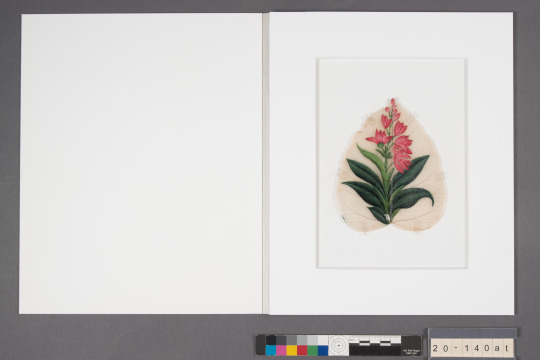
Figure 12: Example of the completed housing, showing the front of a leaf painting.

Figure 13: Back of a leaf painting.
Though my involvement in the project has come to an end, I have gained a very special appreciation for the commonplace book and the preservation challenges it presents. The experience of learning directly from NYU Libraries Special Collections was especially invaluable, providing me with opportunities to participate in complex decision-making processes unique to large research libraries driven by user needs. Before signing off, I’d like to extend my gratitude to my supervisors, Laura McCann, Director, and Lindsey Tyne, Conservation Librarian, and the entire team at the Barbara Goldsmith Conservation Lab for their unwavering support and enthusiasm throughout this project. Thank you all very much!
Notes:
[1] A commonplace book is a centralized place for an individual to record information, whether it be their personal thoughts or quotes from outside literary sources. Friendship albums, by contrast, contain handwritten entries from the family, friends, or acquaintances of the owner (often female). Both forms of commonplacing sustained popularity in Europe and America throughout the 19th century. To learn more about this fascinating literary genre, see Jenifer Blouin, “Eternal Perspectives in Nineteenth-Century Friendship Albums,” The Hilltop Review, Vol. 9, Issue 1 (2016) and Victoria E. Burke, “Recent Studies in Commonplace Books,” English Literary Renaissance, Vol. 43, No. 1 (2013), 153-177.
[2] Much of what is known about Jane Harriet (also known in her family as Harriet) comes from the Blechynden papers in the British Library (Add. Mss. 45578-663). This large holding contains the diaries of her father, Richard (Add. Mss. 45581-653), and older brother, Arthur (Add. Mss. 45654-61). For a secondary account of the Blechynden household, see Peter Robb, Sentiment and Self: Richard Blechynden’s Calcutta Diaries, 1791-1822 (New Delhi: Oxford University Press, 2011).
[3] Michele Matteini, “Written on a Bodhi tree leaf,” Anthropology and Aesthetics, Vol. 75-76 (2021), 45-58.
[4] The design of the double-sided mats is based on an instructional guide made available by the Library of Congress. “Double-Sided Mat,” Library of Congress, accessed 1 February 2023.
[5] We chose not to use adhesives or traditional paper-hinging techniques to mount the leaf paintings for several reasons. As noted, the paintings are on fragile, non-paper-based supports that have an organic coating, which may be derived from plant gum. The leaf supports are thin, translucent, and highly vulnerable to breakage, so applying hinges directly with adhesive might permanently alter their appearance or risk further damage to the leaves over time, especially if they need to be removed from the housing in the future.
Photographs: Alexa Machnik
#NYULibraries#NYUSpecialCollections#FalesLibrary#nyuifa#nyuart#librarypreservation#libraryconservation#collectionscare#artconservation#paperconservation#bookconservation#artpreservation#preservingthepast#PreservationWeek#preservationweek2023
210 notes
·
View notes
Text
Everything You Need to Know About Herbs: Patchouli
Patchouli (Pogostemon cablin)
*Medical Herb *Feminine
*Small note: It is considered poisonous but only because the oil shouldn't be ingested. Since most essential oil cannot be ingested into the body, I did not include it into a poisonous category. Puchu~

Folk Names: Pucha-Pot, Kablin, Pacouli
Planet: Saturn, Mars, Venus
Element: Earth
Deities: Krishna, Athena, Set, Modron, Pan, Osain, Aphrodite
Abilities: Money, Fertility, Lust, and Carnal Desire
Characteristics: Is a hairy, aromatic perennial flowering plant that can grow to 3ft. It has square stems, oval leaves, and spikes bearing whorls of white to light purple flowers.
History: Native to Malaysia and the Philippines. It is now cultivated in tropical and subtropical regions around the world. It is famous as an Eastern perfume oil due to its very strong scent and being known for being an aphrodisiac. The powdered version was introduced into an incense later on, while the dried leaves were used in India as a prophylactic, a medicine used to prevent diseases like malaria. Malays put dried leaves into their clothing to protect them from insects and used the oil to treat smallpox.
Growing Patchouli:
Is it easy to grow? Yes
Rating: Beginner to Moderate (depending on location)
Seeds accessible? No
How to Grow
Video Guide
Where to Buy Seeds
Magical Usage:
A drop of the oil on money, handbags, and wallets can increase prosperity
Using the oil for aromatherapy can help ease the nervous tension and worry
Can be used in money and love spells (do not recommend for love spells since it can bring carnal desire instead of love)
Can be used in fertility talismans and a substituted for graveyard dust (supposedly)
Use to promote lust and attract people, especially for sex workers
Medical Usage:
Used to be used heavily in Asian medicine, featured in Chinese, Indian and Arabic traditions
Can repel insects
Can be used as an antidepressant and antiseptic
It can help with uneven skin tones and help clear skin conditions like skin eczema and acne
Can also help with varicose veins and hemorrhoids
Sources
#patchouli knowledge#witchcraft#witchblr#witch community#green witch#medicinal herbs#plants and herbs#herbalist#occulltism#paganblr#nature#patchouliessentialoil#baby witch#witch garden#gardening#gardenblr#flowers#witchcraft 101#witch tips#witches of tumblr#witchcraft resources#witch blog#beginner witch
42 notes
·
View notes
Text
Cynocephalus
Indica by Ctesias (5th Century BC)
Name literally means dog heads. Supposedly Indians call them Kalystrii
Live in the mountains of India
Can live to be 170, sometimes 200 years old
Look like men with the heads of dogs. Their teeth is larger than that of other dogs, their nails are round and long like other animals. Their skin is swarthy
Above their hips is a tail like a dog's, but longer and hairier [like a wolf's then?]
Understand the speech of humans but cannot replicate it. They communicate via barking and hand signs
Very just, like other Indians
Number around 120,000 at the time of writing [4th century BC]
Hunter pastoralists. Cook animals by leaving them to roast in the sun. Farm sheep (for wool and milk, which they love), goats, and asses
Also eat Siptakhora fruit for its sweetness. Love it so much that they also eat it dried
Trade the fruit for bread, flour, and cotton with the Indians, whom they also buy swords for hunting wild beasts, bows, and arrows
Skilled with bows and hurling spears. Once an animal is wounded they can overtake it, being very fleet of foot
Live in caves rather than houses. Wear skins of animals, tanned and de-furred to look very fine. The richest wear linen, but there are very few of them
Bathe rarely. Women do so only once a month, men only wash their hands. Sometimes (3 times every month) they anoint themselves with oil made from milk and wash themselves with skins
The richest is determined by he who has the most sheep
Have no beds. Sleep on leaves or grass
Every year they send a tribute to the Indian king via rafting on the rivers to his lands: Siptakhora fruit, purple flowers, purple dye, and 1260 talents of amber
The Indian king sends them a present of 300,000 bows, as many spears, 120,000 shields, and 50,000 swords ever five years
24 notes
·
View notes
Text
Trinket Poll Game
Pick stuff from your room and have people vote on what they want to take home

2 notes
·
View notes
Text
Discover the Timeless Elegance of Dried Flowers with World Dried Flowers
Welcome to the World Dried Flowers blog! As a leading dry flower exporter in Kolkata, we are passionate about bringing the beauty and elegance of dried flowers to homes, offices, and events across India and beyond. Our extensive range of high-quality dried flowers is perfect for anyone looking to add a touch of nature’s timeless charm to their surroundings. Visit us at World Dried Flowers to explore our exquisite collection.
Why Choose Dried Flowers?
Dried flowers have been gaining popularity for various reasons, and it's easy to see why they are becoming a preferred choice for decor enthusiasts:
Long-lasting Beauty
One of the most appealing aspects of dried flowers is their longevity. Unlike fresh flowers, which can wilt within days, dried flowers maintain their beauty for years. This makes them a cost-effective and enduring option for anyone looking to enjoy the natural elegance of flowers without the need for constant replacement.
Low Maintenance
Dried flowers require minimal care. There's no need for watering or special attention, making them ideal for those with busy lifestyles or a lack of a green thumb. Simply place them in your chosen spot and enjoy their beauty with virtually no upkeep.
Eco-friendly
Choosing dried flowers is an environmentally friendly option. By reducing the need for frequent replacements, you minimize waste and contribute to sustainable living practices. Dried flowers also do not require the extensive resources that fresh flowers do, such as water and energy for transportation.
Versatility
Dried flowers are incredibly versatile and can complement any decor style. Whether you prefer a rustic, vintage, or modern look, dried flowers can enhance the ambiance of your space. They are perfect for home decor, office settings, and special events, adding a touch of natural beauty to any environment.
Our Exquisite Range of Dried Flowers
At World Dried Flowers, we offer a diverse selection of dried flowers to cater to various tastes and preferences. Here are some of the highlights from our collection:
Roses
Timeless and elegant, our dried roses come in a variety of colors and are perfect for adding a romantic touch to any setting.
Lavender
Known for its soothing fragrance and delicate appearance, dried lavender is a popular choice for creating a calming atmosphere.
Hydrangeas
These beautiful blooms add volume and texture to any arrangement, making them a versatile option for various decor styles.
Wheat Stalks
Ideal for rustic and natural-themed decor, wheat stalks bring a touch of the countryside into your home or office.
Customized Arrangements
We also offer customized arrangements tailored to meet your specific needs for weddings, corporate events, and other special occasions. Let us create the perfect arrangement to complement your event's theme and style.
The Growing Trend of Dried Flowers in India
Dried flowers are becoming increasingly popular in India for various applications. Their unique beauty and durability make them a preferred choice for decor enthusiasts across the country.
Home Decor
Enhance the aesthetic appeal of your living spaces with our exquisite dried flowers. They are perfect for creating stunning centerpieces, wall hangings, and other decorative accents.
Office Decor
Add a touch of elegance and tranquility to your work environment with our dried flowers. They can brighten up any office space and create a welcoming atmosphere for employees and clients alike.
Event Decor
Dried flowers are ideal for weddings, parties, and corporate events. They provide a chic and sophisticated look that can elevate the ambiance of any event. From centerpieces to floral arches, our dried flowers can help you create unforgettable decor.
Convenient Online Shopping
Shopping for dried flowers online in India is easy and convenient with World Dried Flowers. Our user-friendly website allows you to browse and purchase from the comfort of your home:
Wide Selection
Explore our vast collection of dried flowers, each carefully selected to ensure the highest quality.
Simple Ordering Process
Enjoy a seamless and secure online ordering process. With just a few clicks, you can have your favorite dried flowers delivered to your doorstep.
Nationwide Delivery
We deliver to various locations across India, ensuring that your dried flowers arrive safely and promptly.
Why Choose World Dried Flowers?
As a leading dry flower exporter in Kolkata, World Dried Flowers stands out for several reasons:
Experience and Expertise
With years of experience in the dried flower industry, we have the knowledge and expertise to provide the best products and services to our customers.
Quality Products
We are committed to offering only the finest dried flowers. Each flower is handpicked and carefully preserved to ensure its beauty and longevity.
Customer Satisfaction
Customer satisfaction is our top priority. We strive to meet and exceed your expectations with our high-quality products and exceptional service.
Competitive Pricing
We offer premium dried flowers at affordable prices, making it easy for you to add a touch of elegance to your decor without breaking the bank.
Hear from Our Satisfied Customers
Don't just take our word for it—here's what some of our satisfied customers have to say:
“The dried flowers I ordered from World Dried Flowers were stunning and lasted for months. Perfect for my home decor!” – Aarti M.
“Their customer service is excellent, and the flowers arrived in pristine condition. Highly recommend!” – Rahul K.
“I used their dried flowers for my wedding decor, and it added a magical touch to the event. Absolutely beautiful!” – Priya S.
Get in Touch
Transform your space with the timeless beauty of dried flowers from World Dried Flowers. Visit our website at World Dried Flowers to explore our collection and place your order today. For any inquiries or customized orders, feel free to contact us. Let us help you bring nature’s elegance into your life with our exquisite dried flowers.
#dried flowers#dry flower#dried flowers india#world dried flowers#dried flowers online India#dry flower exporter in Kolkata
0 notes
Text







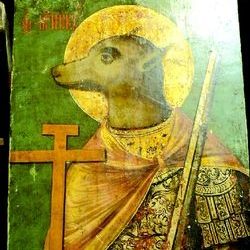

St. Christopher, The Christbearer
Dog-man, Cynocephali Saint, christened by baby Jesus after helping him cross a river.

The Dogheaded people
They were seen by conquerors, explorers, evangelists and described in detail. Alexander the Great, Marco Polo, St. Augustine, Christopher Columbus all described these creatures. You also have Anubis the Egyptian god and St.Christopher who was converted to Catholicism and achieved Saint-hood by helping believers cross a river.
There were letters corresponding with the Vatican on whether or not these dog headed men could be saved or not. The Catholic church was not surprised and simply asked if their eyes were on the front of their heads or on the sides. Apparently dog headed men were nothing new to cultures around the world.
'Ratramnus’s Epistola de Cynocephalis, is a letter written concerning if dog headed men could be saved. The response was yes based on the evidence that they showed the ability to have free will; they wore clothes, kept animals, had relationships, and obeyed laws etc. So they could choose salvation and therefore could be worth ministering to.
( Canaanites = canines, described as cannibals and great fighters who did detestable things.)
In Tibet there was recorded history of over 200,000 living in a village.
They lived in Parts of India along the Mountain Range, there are traces of them in the Celtic lands they lived in Ireland.
St. Christopher is the patron saint for travelers. Dog-headed people often have acted as guides, ferries and Shepards. I will cover this in a future post, which will feature Xolotl and Aztec Gods, including Anubis!
Canines are interwoven into human history.
On these mountains there live men with the head of a dog, whose clothing is the skin of wild beasts. They speak no language, but bark like dogs, and in this manner make themselves understood by each other. Their teeth are larger than those of dogs, their nails like those of these animals, but longer and rounder. They inhabit the mountains as far as the river Indus. Their complexion is swarthy. They are extremely just, like the rest of the Indians with whom they associate. They understand the Indian language but are unable to converse, only barking or making signs with their hands and fingers by way of reply, like the deaf and dumb. They are called by the Indians Calystrii, in Greek Cynocephali (“dog-headed “). [They live on raw meat.] They number about 120,000. Near the sources of this river1 grows a purple flower, from which is obtained a purple dye, as good in quality as the Greek and of an even more brilliant hue. In the same district there is an animal about the size of a beetle, red as cinnabar, with very long feet, and a body as soft as that of a worm. It breeds on the trees which produce amber, eats their fruit and kills them, as the woodlouse destroys the vines in Greece. The Indians crush these insects and use them for dyeing their robes and tunics and anything else they wish. The Cynocephali living on the mountains do not practice any trade but live by hunting. When they have killed an animal they roast it in the sun. They also rear numbers of sheep, goats, and asses, drinking the milk of the sheep and whey made from it. They eat the fruit of the Siptakhora, whence amber is procured, since it is sweet. They also dry it and keep it in baskets, as the Greeks keep their dried grapes. They make rafts which they load with this fruit together with well-cleaned purple flowers and 260 talents of amber, with the same quantity of the purple dye, and 1000 additional talents of amber, which they send annually to the king of India. They exchange the rest for bread, flour, and cotton stuffs with the Indians, from whom they also buy swords for hunting wild beasts, bows, and arrows, being very skillful in drawing the bow and hurling the spear. They cannot be defeated in war, since they inhabit lofty and inaccessible mountains. Every five years the king sends them a present of 300,000 bows, as many spears, 120,000 shields, and 50,000 swords. They do not live in houses, but in caves. They set out for the chase with bows and spears, and as they are very swift of foot, they pursue and soon overtake their quarry. The women have a bath once a month; the men do not have a bath at all, but only wash their hands. They anoint themselves three times a month with oil made from milk and wipe themselves with skins. The clothes of men and women alike are not skins with the hair on, but skins tanned and very fine. The richest wear linen clothes, but they are few in number. They have no beds, but sleep on leaves or grass. He who possesses the greatest number of sheep is considered the richest, and so in regard to their other possessions. All, both men and women, have tails above their hips, like dogs, but longer and more hairy. They are just, and live longer than any other men, 170, sometimes 200 years (Ctesias, “Indica”, from Photius I).



21 notes
·
View notes
Text







A vent piece that I really needed- started in March and finished in April! This piece stemmed from a week or two where everything felt so awful and completely suffocating mentally that I felt I could collapse at any moment under the weight of it. Everything felt sharp and hurt deeply, and this is what I was turning to work on during that time; when I’m in that headspace and do have the emotional energy, my optimism is still there…it just has gnashing teeth. I survive and endure because it’s all I know how to do, for better or for worse…but sometimes that’s okay, and that’s enough, enough to get me through. Thankfully for me, things always get better and I have no choice, whether I like it or not! (I’m feeling a lot better since then, despite being in my hard month right now…maybe it’s fitting that I’m posting this when I am 🖤)
This piece was of course about those raw, sharp feelings and surviving out of spite, but it was also all about texture- giving myself the space to LEAVE edges torn, to paint splatter and get out of my own head for a bit, to let things BE messy and imperfect and bleed in to each other. Hand-dipping the spikes in India ink was something I’ve wanted to try forever, but it felt very right to finally get to do it on THIS piece. This one needed it, and I think I needed it too.
Suffice to say, I’m incredibly proud of this one. It came from a very personal part of me, and helped me endure a really bad time…I can never thank art enough for that. I hope you guys enjoy it too, and I’ll also be putting it up in my shop on June 1st! 🥰🔥
(Tap for best quality!! 🖤)
Wood panel, book pages, tape, dried flowers, India ink, Distress Oxide stamp ink, acrylic paint, pins, spikes
#spikes for days#vent art#mixed media#mixed media art#statement art#one of a kind#artists on tumblr#artists on instagram#my art#sunshinedustartistry
4 notes
·
View notes
Text
Indie Perfume Recommendations: India Stoker

Alkemia - Baccante
New torn grass, fresh peeled apples, bitter green-ness, and a hint of earthy tree bark. Smells like India’s favored past-time of exploring the outdoors in her nightdress, and centers on a combination of clean fruit with muddy, torn vegetation. It dries down to the scent of mild dried berries, which feels appropriate for India’s youth and frequent featuring alongside lush nature imagery when she is in her element.
Alkemia - Apotheosis of Rose
A full-bodied and dimensional raw rose, soapy and surgically precise in its execution. Evocative of India’s fresh, precise aesthetic and behavior while also encompassing the “green-ness” of her relatively sheltered and introverted character.
Strange South - Poor Dove
Smells more like India’s bedroom than anything else. Dense and dusty old woods, timeless amber, and the juvenile saccharine notes of sugared flowers combine with crisp paper and stagnant air to produce the atmosphere of India’s headquarters. Don’t be deceived by its waxy, blasé opening, this perfume holds a luxurious but sweetly uncanny vibe if you let it settle.
Alkemia - Magnolia Au Vert
Despite a piercingly grassy opening, this dries down into subtle, fresh magnolia scent that keeps its youth via its photorealistic quality. This is a classic scent that mirrors India’s classic aesthetic and reserved demeanor. Magnolia au Vert is plain and natural, and can be deceivingly green and sharp at first application, but evolves into something deeper, richer, and more complex as you grow to understand it, like Stoker herself.
Strange South - Concrete Angel
Another scent that features classic Southern smells such as Magnolia and red clay. This is a light and bright floral composed of familiar Southern garden flowers, but with a barely-tangible vein of earthy darkness running through it. This is one of my signature perfumes, and I think it connects to the character of India Stoker quite well through its combination of youthful, timeless freshness and familiar, smooth florals over the line of loamy intrigue.
#india stoker#stoker#american gothic#fragrance#perfume#indie perfume#perfume recommendations#rural gothic
8 notes
·
View notes
Text
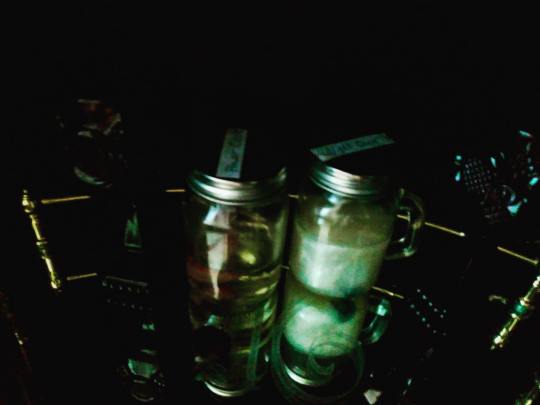
Photograph: Featured here is Flower Circle and Night Owl.
Magickal body oils
Some things to consider when making body oils.
What are the skin benefits of the non toxic plants you are using?
Do any of the plants you intend to use irritate the skin in any way? Some plants are capable of irritating the skin such as Prairie Fleabane, which can cause mild dermatitis.
Are any of the plants you intend to use toxic or poisonous? Do not use toxic or poisonous plants ever on the skin. The skin absorbs anything put on it, such as, lotions, balms, and oils. Never use harmful substances in skin or body oils.
Do not use any plant, herb, or flower that you are allergic to.
After rinsing jars or bottles for making your oils, make certain the container is completely dry. Using a container with water on the inside, will result in molding botanicals. To increase the shelf life of the oil, make certain there is no water mixed with your base oil.
Always seek the advice of a medical professional. Some herb and plant material can interact with medications. Bring up any concerns you have with your primary care physician.
Discontinue use of any product which irritates the skin or that which you have any reaction to.
Remember if you want a product with less plant matter that you can strain your oil. First let the herbs stay in the oil in indirect sunlight for a few weeks to infuse the oil. This is the folk method of infusing botanical oils.
There are safe ingredients you can use to color your oils to make them more appealing.
Mica powders are safe for cosmetic use to color your oils.
Scent: Flower Circle
Half a blend of botanicals and fragrance oils,with a touch of rose and ritual, this oil is perfect for the green, hedge, or fae witch.
Intention: Love. Botanicals used relate in symbolism to loving intentions.
Medicinal Qualities: Soothes and softens skin, while reducing lines and wrinkles.
Ingredients:
Base oil.
Banded Agate.
Rose petals.
Three Virginia spiderwort petals.
Witch's money bag leaves.
Rose garden and white musk fragrance oil.
Five petals of narrow leaf sundrop, or Evening Primrose.
This blend was foraged locally from the yard of this hedge witch. Every medicinal and magickal ingredient was fully researched and lovingly dried and added to the base oil. This is an oil, that as I write this, I am preparing myself.
Using rose to soften skin and narrow leaf sundrop to reduce wrinkles this is a great oil for the intention of love. Magick and medicine are combined in hedge witch fashion.
Scent: Night Owl
Magickal body oil
Intention: Protection.
Medicinal qualities: Relaxation, and helps alleviate sinus issues.
With touches of night and campfire ritual this is a great oil for personal protection.
Ingredients
Base oil
Snowflake obsidian
Dried purple lilac flower
Dark amethyst fragrance
Fire amber fragrance
White musk fragrance
Dried spearmint leaves
With this particular oil I like to energetically link it to a full moon cycle. It begins to charge on a full moon and grows more potent until the end of the moon’s waning phase. Bringing in protection.
Scent: Moon over India
Magickal body oil
Intention: Psychic development. Enjoy developing clair ability with this luxurious fragrance.
Ingredients
Base oil.
Amethyst piece (optional).
Jasmine buds.
Moonlit path fragrance oil.
Nag champa fragrance oil.
7 notes
·
View notes
Text
Travel Sketches (Nov 2023 - March 2024)
Nov 2023.
Bishnumaya just turned 100 this October. She comes from Pokhari, about 15 kilometers from Mirik town. As we spoke, she recalled old memories, her expressions shifting as if reliving those moments. She seemed elsewhere, gazing past me into the distance, and then, as if continuing a conversation with herself, she said, “Nowadays people ask about caste when they meet someone, and how is that of any use?”
She described how, when she was small, there were no proper schools in her village. She learned to read and write, however little, by arranging corn kernels on the ground to form shapes that resembled letters and numbers. Reflecting on her long life, she added that everyone around her—friends her age and younger siblings—is dead, and she feels like a monster who swallowed them all.

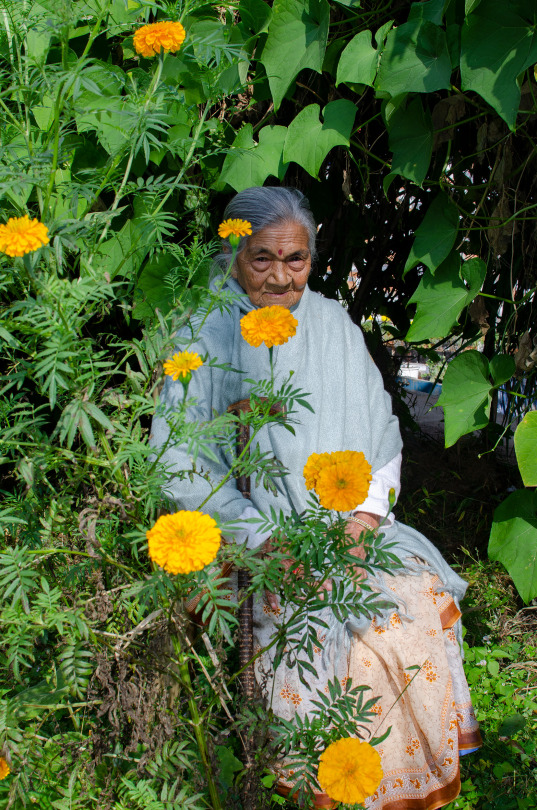
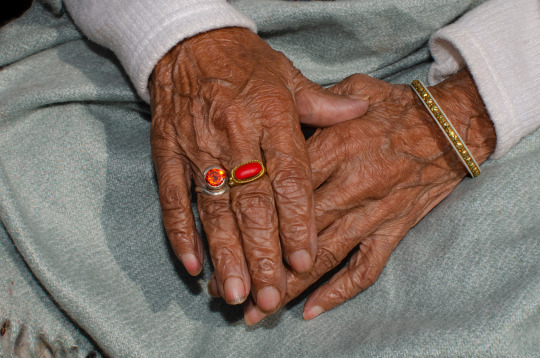
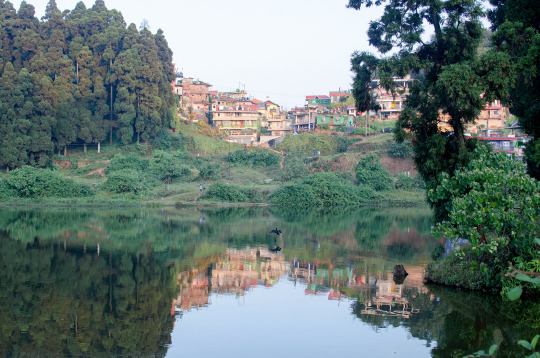
The sun is out, but it’s only warm where the light falls. The history of Mirik is reflected in its lake, which used to be a marshland. According to Wikipedia, the name Mirik comes from the Lepcha words Mir-Yok, meaning "place burnt by fire." It's very green now for a place that was once burnt.
A town fair is underway, offering a range of attractions: a Ferris wheel, flower park visits, fast food stalls, ice cream carts, horse and boat rides, live pop music, card game betting, balloon shooting, local bingo-type card games, and hoopla with prizes up for grabs. Some prizes are cash with notes of 20, 50, and 100 rupees.
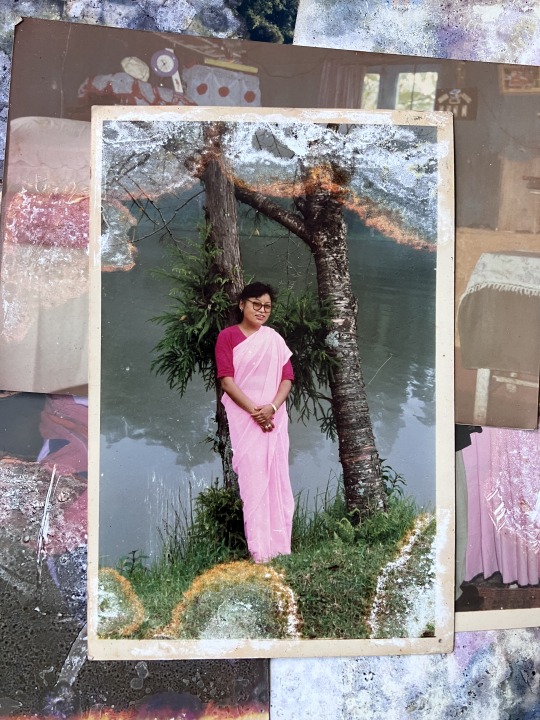
——
For the past ten years, I haven't had a permanent home. When I wanted to sidestep the weight of planning and longed for comfort and familiarity, I returned to places I liked a little more than others: Auroville, Dharamshala, Shillong, Aizawl, Nagaland.
I like meeting new people and have formed what feels like extended families in some of these places. Since I have mostly felt free to move around, sometimes nostalgia of people or a time or a curiosity to see how things may have changed would draw me back to a place.
Earlier in August, while I was temporarily living in Auroville, I got a call about a six-month project called The Great Himalayan Exploration, a collaboration between UNESCO and Royal Enfield. The project aims to document the intangible cultural heritage of local communities in the Himalayan region of Northeast India.
My work on this trip specifically involved photographing the people behind various cultural practices and examining the ecosystems they exist in. To build context, I engaged in various methods, such as scanning old photos from people’s personal albums, taking photos of their living spaces, landscapes, and exploring archival resources. From November to April, we were in West Bengal, Sikkim, Tripura, Mizoram, Assam, Nagaland, and Meghalaya.
------
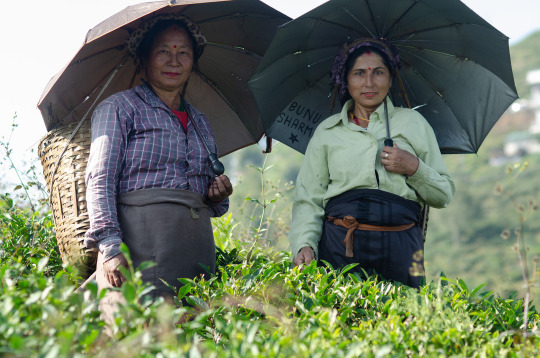
On our way back to Siliguri from Mirik, we made a lengthy stop near a tea estate. Lalita, from Tingling village, shared that she had spent two decades working on the estate, much like many other women from the village. Their collective hope was to earn a minimum of 500 rupees per day for their labor. Currently, they are receiving 250 rupees per day for an eight-hour shift.
------
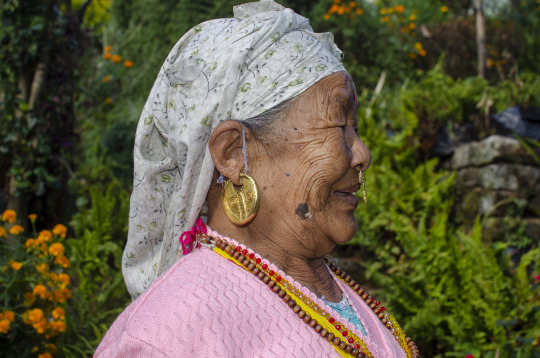
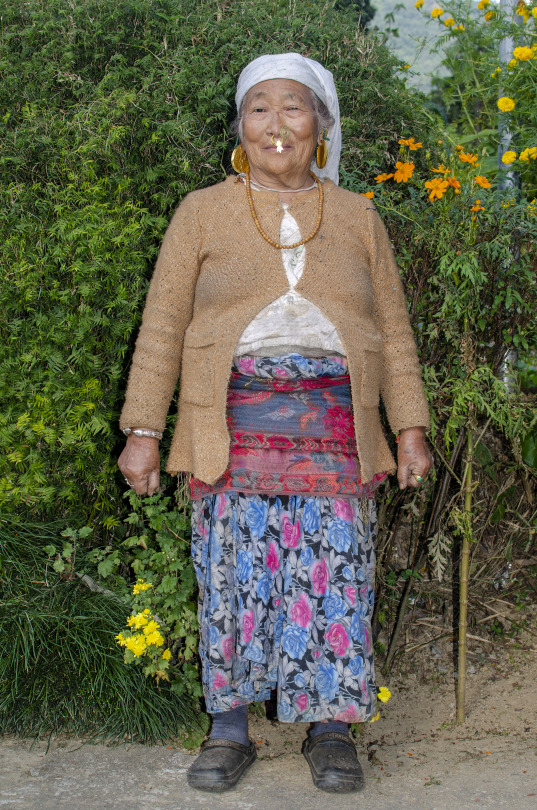
Sanchamaya, 74, sits with her friend Bodhimaya in the front yard of her house in Darap, both lifelong farmers of the area and belonging to the Limbu community. They're nice and welcoming. It's our second day in Pelling, West Sikkim, and I've ended up at the wrong house. Today, we're supposed to see a drum dance(chyabrung) performance by local Limbu boys, which I'll catch later.
They talk in basic broken Hindi, with Shusan translating most of it. Sanchamaya leads me to the back of their house, where she proudly shows me trays of dried large cardamoms. Later, we'll visit her cardamom field. They also cultivate Mosambi, oranges, guavas, maize, peas, ginger, and onions. Sanchamaya spends her days with her friend, grandchildren, working in the fields, and cooking in the kitchen.
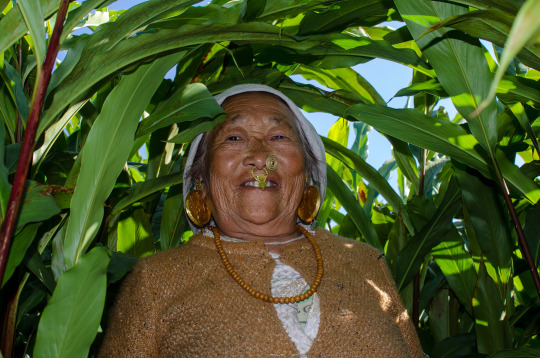

------

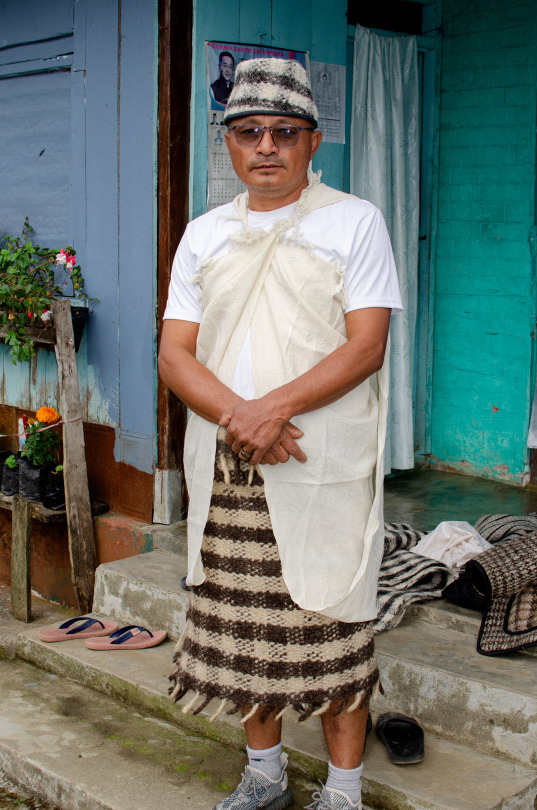
I visited Chuba village, 3 hours away from Gangtok, with Semeon from Haflong, Assam, a textile design graduate from NID and working at Sonam’s design studio called EchoStream based in Gangtok. Semeon was familiar with the village and the community I was there to meet. Arun Gurung and his wife, founders of Chubako, are endeavoring to revive an old tradition of sourcing wool from indigenous banpala sheep to make clothes. They operate a small cooperative called Chubako. In this village of 43 families, one person from each household now works for Chubako. (photo above: Arun Gurung, founder of Chubako)
(photo below: Designed by Sanskruti Shukla, co-created with the craft community of Chubako for Echostream, Gangtok)
Local stories of the craftspeople of Chuba are showcased and incorporated into wool through interactive workshops focused on storytelling and design development. The felted art rugs depict the flora and fauna of Sikkim.
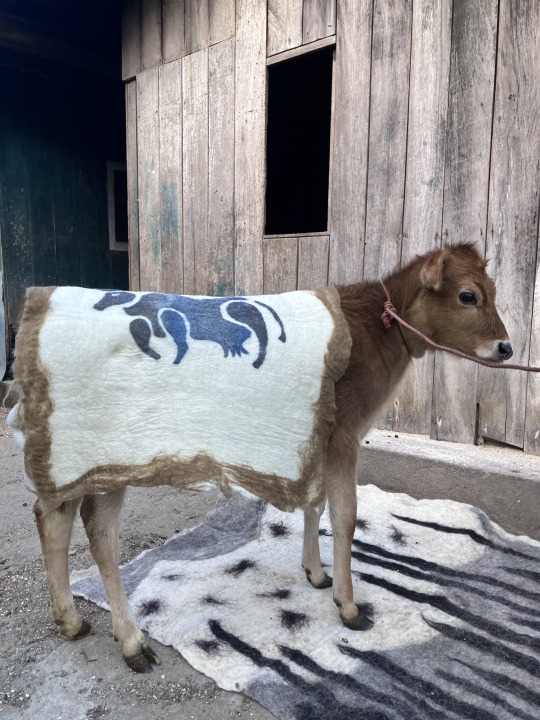


Gangamaya Gurung, 83, Arun Gurung's mother, lit up like a child when she saw Semeon. They shared a bond akin to best friends. Despite her age, Gangamaya remains active, tending to sheep, cutting grass, farming, and weaving. When asked about her leisure activties, she said, "eat, watch TV - eat, watch TV."
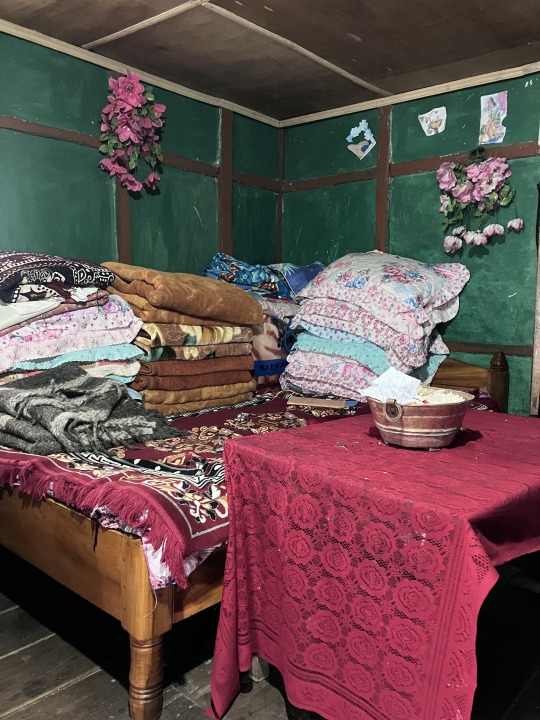
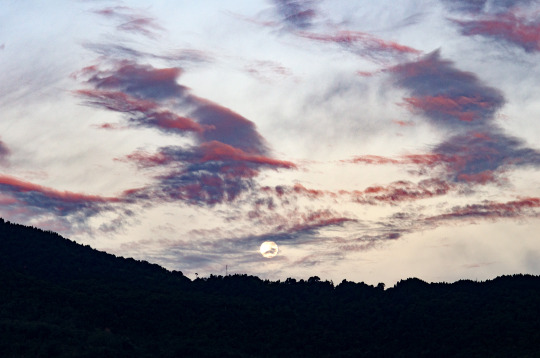

Sampati Debbarma, a farmer, returning from work in Takarjala, Tripura.
--------
Jan, 2024.
We have been out on this trip for 3 months. My thoughts scattered in a kind of bardo between the world I know and the world I am coming into contact with. I picture house fronts with flowers in Darjeeling, roads winding, the long cold rivers snaking toward mountains that seem no bigger than my thumb, the snow capped peaks shifting colours, the prayer flags in high altitudes and on house doors. Gangtok’s Lal Bazaar skateboarders flash by, a school in Tripura where a student lives on 700rs a month, nini bung tamo and 4 other sentences I learned in Kokborok nag me like a tune. Sidangcherra to Pecharthal to Panisagar to Damchara checkpoint we make our way from Tripura into Mizoram by road. I think about where I will be later in the summer and see a white fluffed cloud taking the shape of a growing tree far on the horizon.
——

Krismas Ruaitheh(Christmas feast) at Khatla Presbyterian Church, Aizawl. This is my 3rd time in Aizawl. I used to go for dinners, sometime evening tea to my friend’s family house further up the road from the Khatla church. We are here to document the traditional community feast of the Mizos.

Priscilla is currently pursuing her BA in Political Science in Delhi, and she's home for the holidays. She was volunteering at Khatla Presbyterian Church where she and her friends were tasked with serving lemonade, a customary drink after the meal. For Priscilla, the most remarkable aspect of the feast is its longstanding tradition — dating back to pre-Christian times — where the entire community comes together to share its moments of joy and sorrow + they still use Changel Hnah (plantain leaves) — the traditional way to serve meals.
-----
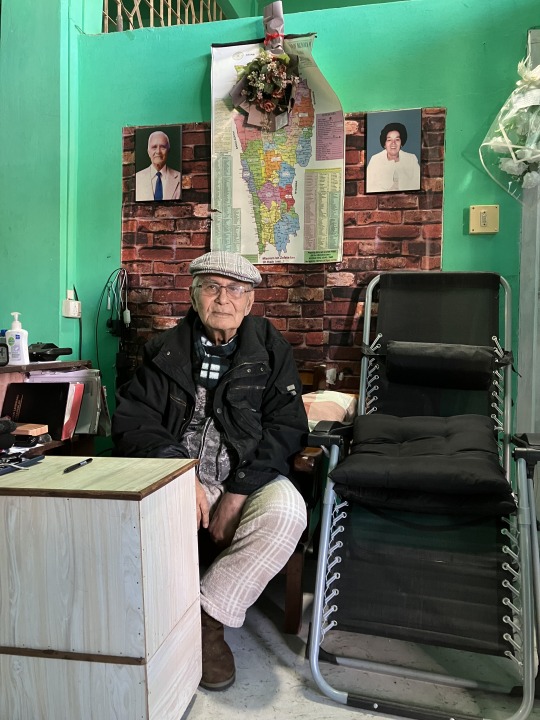
On an idle walk one evening in Khatla, I find myself in a local thrift store and get invited to meet James Lalhmingliana. He is 80, one of the founding members of Aizawl's first bike club, Aizawl Thunders. He went to school at Sts. Edmund’s in Shillong.
In 1966, he joined the Mizo National Front uprising, fighting for freedom. He went underground for seven years, first in Arakan, Burma, then in 1969 to East Pakistan for shelter. "It was useless," he says. "We wasted our good years. When I came back, I was put in jail, but not for long."
He has been housebound for years due to his health.
———


At 8 am on a cold January morning, we arrive at Joonbeel Mela. (Joon and beel are Assamese terms for moon and wetland. The Tiwa community first organized this in the 15th century to exchange goods between indigenous tribal communities in Assam and the surrounding areas.)
It is known as the only fair in India where people still practice barter, exchanging goods like fish, sweet potatoes, yam, homegrown vegetables, turmeric, chili, kali miri, and rongalau.
Over a few hours, I have brief interactions with people from Jagiroad, Pamlatar, Deosal, Sira, Changsari, Potia Pathar, Bengenabari, Palahguri, ulukunchi, morigaon, Nagaon, Saru Amli, Belguri, Damal, and places as far as Langpih, mawlynnong in Meghalaya. No one refuses a photo.
—

This is my fifth time in Nagaland. I first came here ten years ago and stayed at Kevesho's home. He is the father of the Tetseo Sisters, a well-known folk group of four sisters from Nagaland.
Kevesho Tetseo, son of Nülhüprü Tetseo was born in 1950s in Thüvopisümi village, Phek District, Nagaland. Initially schooled in the village, he finished his HSLC at Government High School in Kohima and graduated from Kohima College in Arts. He worked in the Education Dept. for sometime and now retired. Active in cultural music, Chokri language preservation, and in church choir since his youth.
(Tati - - a single string musical instrument which is used as an accompaniment with singing of li- indigenous songs by the Chakhesang Nagas.)
Kevesho learned how to make Tati from observing elders in his village when he was young and has done Tati making work since 1990s and a good number of it has been produced till date by him including improvising it for longer life by using steel wires as strings.
He tells me, the woven shawl he is wearing in the picture is "thipiqhü". It is the most prestigious shawl (indigenous cloth) among many traditional clothes of the Chakhesang tribe. It is a shawl they wear with humility and honour.
“Nagaland is my home and I love my culture, its rich traditional heritage, and the natural beauty.”
-----
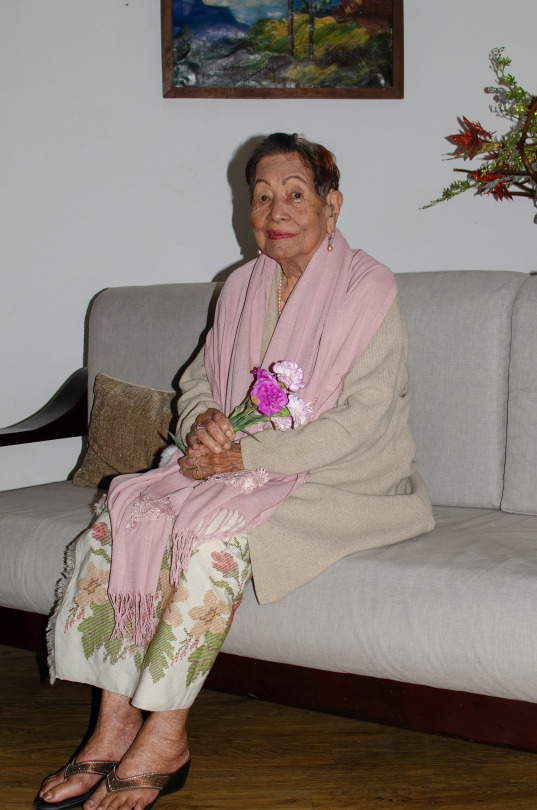
Daisy Yaden was born in Zotlang, Mizoram. She studied at the Welsh Mission School in Mission Veng, Aizawl. She will turn 98 this June. She learned to weave shawls on a backstrap loom, stitching, and baking from her mother, often baking cakes in the fireplace. She taught in the interiors of Nagaland, in places like Noklak and Changtongya. She started her career by teaching people self-sufficiency—how to cook, make jams and pickles—skills she picked up from a British magazine called Woman’s Own. She used to compose little tunes for children at Sunday school. She loves flower gardening and her favourite film is "Gone with the Wind."
Photographed at her house in Duncan, Dimapur.
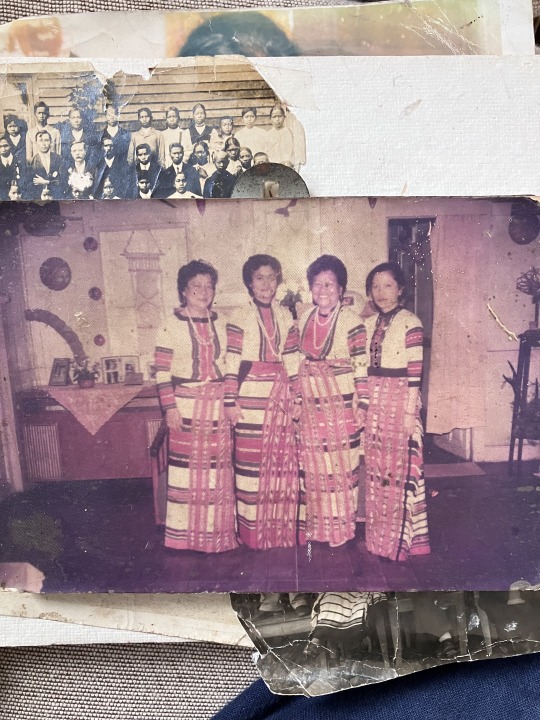
I am sitting with Marian, Daisy's daughter, at her house in Duncan. Marian, now 75, lived in Bombay from 1970 to 2012. She went to college there and worked as an air hostess with Air India for 34 years. In 2012, she returned to Nagaland. We agreed to meet again for lunch and look at her old photo albums.
(below: Marian,16, in Kohima trying a sari for the first time / in Santa Cruz, Bombay in the 80s with James Ferreira and friends)
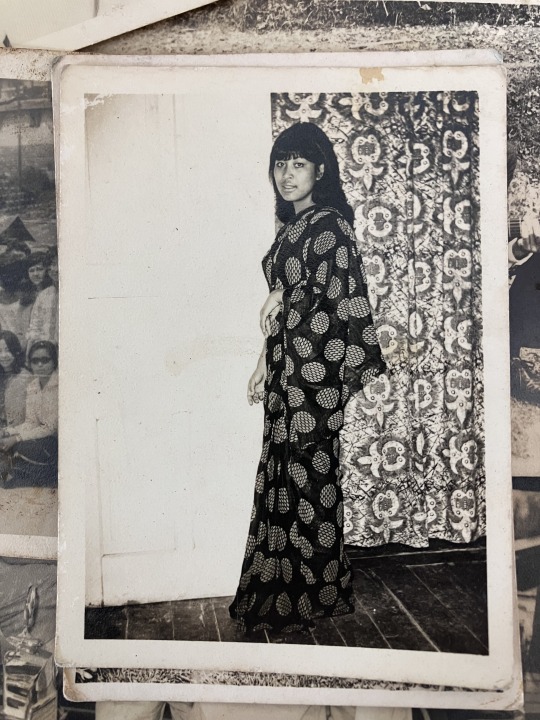


——-
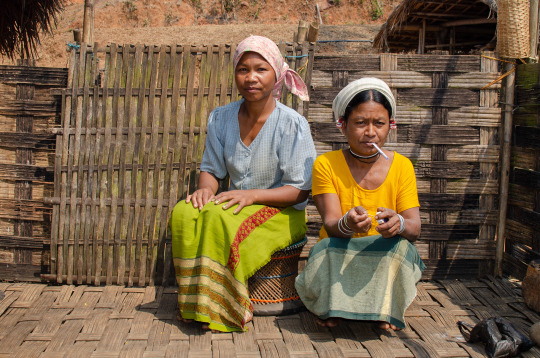
Khinchi is Christian, and Sindri is Songsarek, belonging to one of the last animism practising communities. I learned a few words in Achik: Khading bo, Methela, Namja, and Manja. Here I am in the extended kitchen space at Sindri's hut, in Sadolpara, Dadenggre, where they are taking a break from cooking lunch.
-----
First published in Hindustan Times June '24
0 notes
